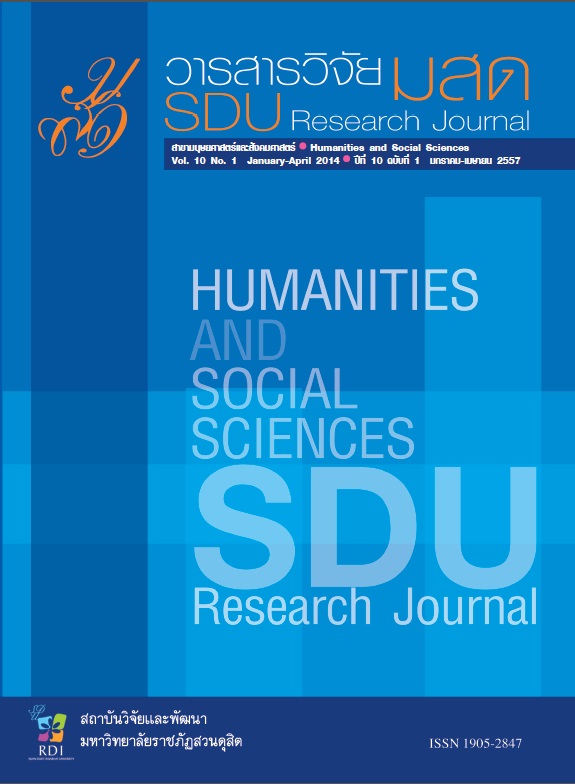คำศัพท์พื้นฐานภาษาอังกฤษสำหรับนักเรียนไทยชั้นประถมศึกษาปีที่ 1-3
Keywords:
คำศัพท์พื้นฐาน, ภาษาอังกฤษ, นักเรียนชั้น ป.1-3Abstract
บทคัดย่อ
การศึกษาเรื่องคำศัพท์พื้นฐานภาษาอังกฤษสำหรับนักเรียนไทยชั้นประถมศึกษาปีที่ 1-3 มีวัตถุประสงค์เพื่อศึกษาค้นคว้า และสร้างบัญชีคำศัพท์พื้นฐานสำหรับใช้สร้างบทเรียนภาษาอังกฤษของนักเรียนไทยระดับชั้นประถมศึกษาปีที่ 1 ชั้นประถมศึกษาปีที่ 2 และชั้นประถมศึกษาปีที่ 3 ในประเทศไทย โดยใช้วิธีการสร้างเดียวกันกับของ Paul Nation ที่สร้างบัญชีคำ General Service List (GSL) กระบวนการจัดสร้างบัญชีคำศัพท์พื้นฐานนี้แบ่งเป็น 5 ขั้นตอนสำคัญดังนี้ คือ (1.) รวบรวมคำศัพท์จากหนังสือเรียนภาษาอังกฤษสำหรับนักเรียนต่างชาติ ชั้นประถมศึกษาปีที่1 ปีที่ 2 และ ปีที่ 3 จำนวน 15 เล่ม และจากหนังสือเรียนภาษาอังกฤษสำหรับนักเรียนเจ้าของภาษา Grade 1 2 และ 3 ของสหรัฐอเมริกา อีก 6 เล่ม คำที่รวบรวมได้จากหนังสือเหล่านี้ มี คำทั้งหมด 145,097 คำ (2.) จัดเรียงคำตามลำดับคำตามความถี่จากสูงไปต่ำ (3.) เปรียบเทียบคำที่มี “ความถี่ในการใช้สูง” ในการศึกษาครั้งนี้ 1000 ลำดับแรก กับ The First 1000 words of GSL พบว่ามีคำเหมือนกัน 546 คำ ส่วน The Second 1000 words of GSL มีคำเหมือนกัน 262 คำ และมีคำที่ไม่เหมือนกับคำใน GSL จำนวน 192 คำ คำประเภทหลังนี้จัดเป็นคำที่มีความถี่ไม่สูงตามแนวทางการทำบัญชีคำของ GSL แต่เป็นคำที่มีความถี่สูงในหนังสือเด็ก (4.) จัดแยกคำที่มี “ความถี่ในการใช้สูง” ในการศึกษาครั้งนี้ เข้ากับกลุ่มคำทางความหมาย (semantic fields) ของ Linguistics Research Center ของ The University of Texas at Austin พบว่าคำ 1000 คำนี้ แยกกลุ่มตามความหมายได้ครบทั้ง 22 กลุ่ม (5.) คัดเลือกคำที่มีความถี่ในการใช้สูง จากการศึกษานี้จัดทำบัญชีคำพื้นฐานสำหรับชั้นประถมศึกษาปีที่ 1 ชั้นประถมศึกษาปีที่ 2 และชั้นประถมศึกษาปีที่ 3 เกณฑ์การคัดเลือกที่ใช้ คือ (1) ความถี่ (2) เกณฑ์สิ่งแวดล้อมของนักเรียนในประเทศไทย” คำพื้นฐานที่เสนอจัดให้นักเรียนชั้นประถมศึกษาปีที่ 1 มี 200 คำ ชั้นประถมศึกษาปีที่ 2 มี 350 คำ ชั้นประถมศึกษาปีที่ 3 มี 450 คำ คำของแต่ละระดับไม่ซ้ำกัน โดยใช้หลักการว่าชั้นประถมศึกษาปีที่สูงขึ้นไปได้เรียนรู้คำที่สอนในระดับชั้นที่ต่ำกว่าแล้ว
คำสำคัญ: คำศัพท์พื้นฐาน, ภาษาอังกฤษ, นักเรียนชั้น ป.1-3
Abstract
The purpose of this research was to construct lists of English core vocabulary for Thai students studying in the first three grades of elementary school. The study used the same type of construction principle that was used by Paul Nation when he constructed the General Service List (GSL). There were five major steps involved in the construction of the English core vocabulary lists:
1) The words and word frequencies in 21 English textbooks were counted (15 textbooks for non-native speakers and 6 textbooks for native speakers of English in the United States). The total number of words counted was 145,097 words.
2) The words were arranged according to frequency, from high to low.
3) The first 1,000 words of this study were compared to the first 1,000 words of the GSL. It was found that 546 words were in common with the first 1,000 words of the GSL. Only 262 words were found in common with the second 1,000 words of the GSL. The remaining 192 high frequency words in studied children’s books were not found in both GSL word lists.
4) The first 1,000 words of this study were categorized according to semantic fields created by the Linguistics Research Center of The University of Texas at Austin. The words filled all 22 of these fields.
5) Word frequency and the Thai students’ environment were used as criteria for selecting words for the construction of the English core vocabulary lists. The results were that 200 words were assigned for the first grade, 350 words for the second grade, and 450 words for the third grade.
Keyword: core vocabulary, English language, first, second, and third grades







